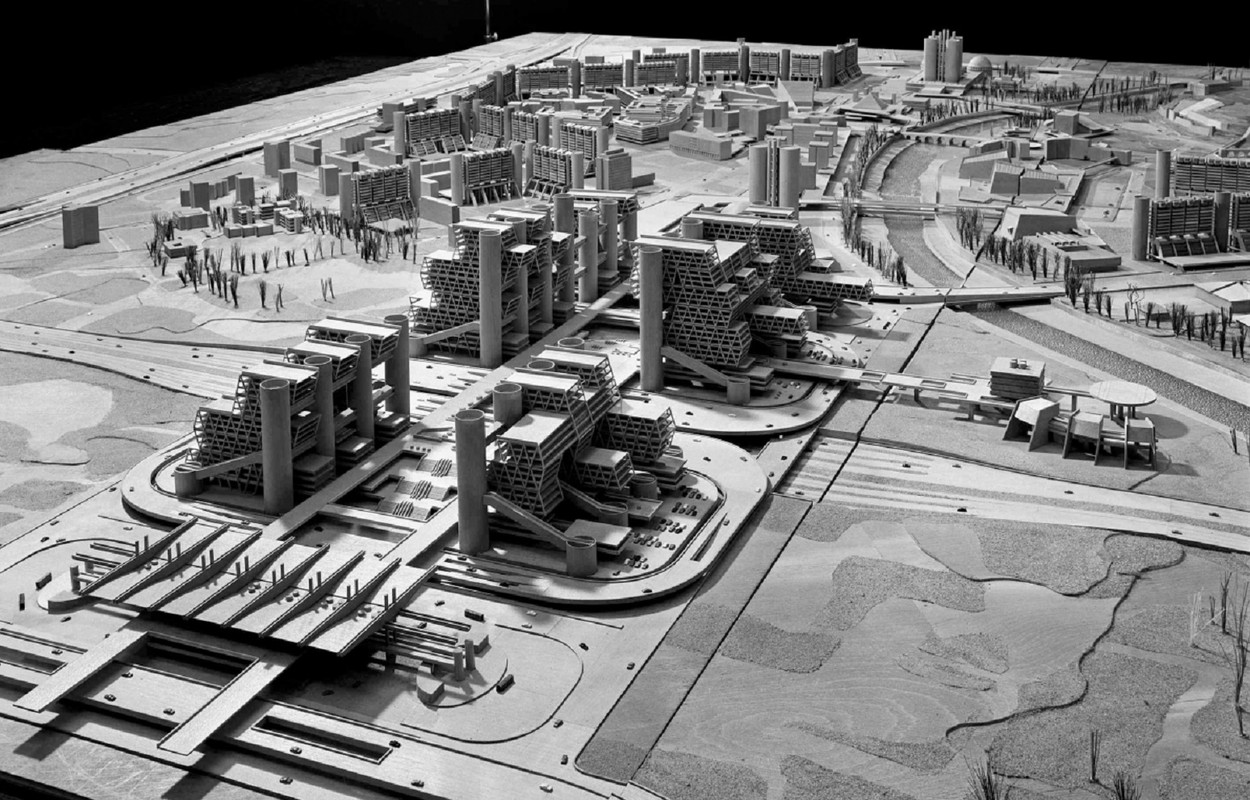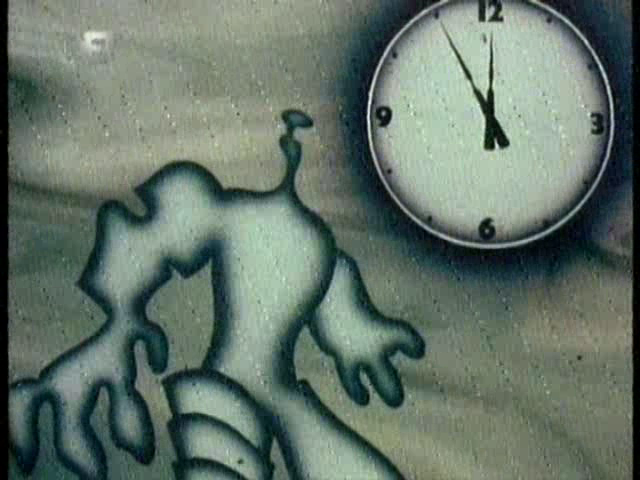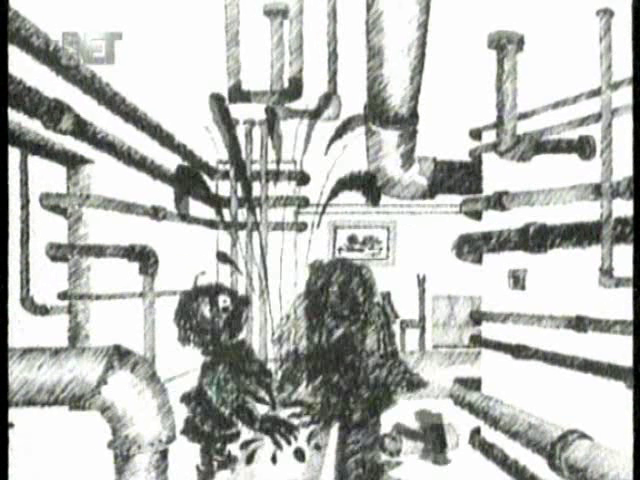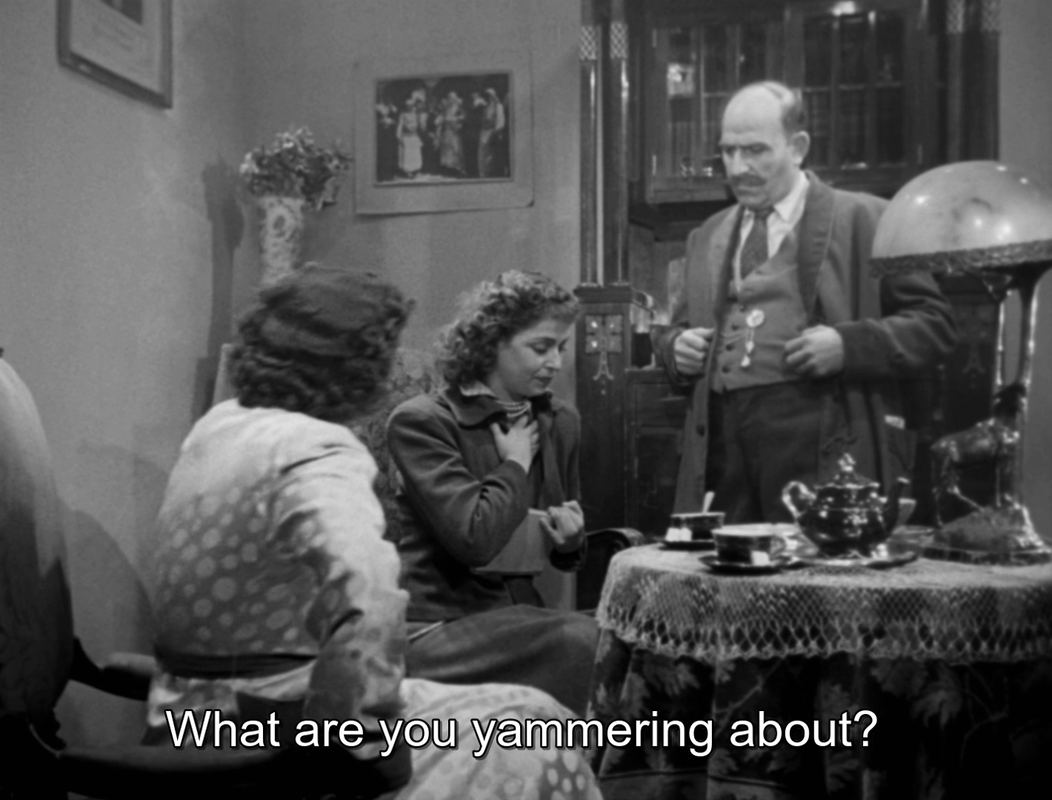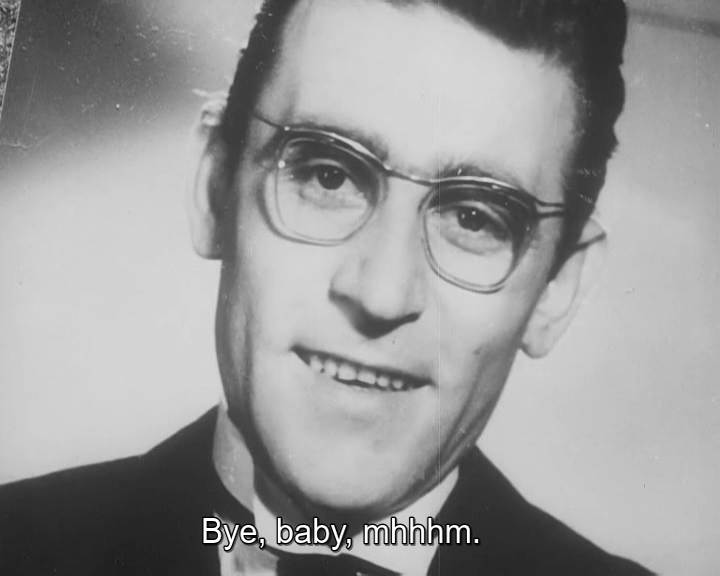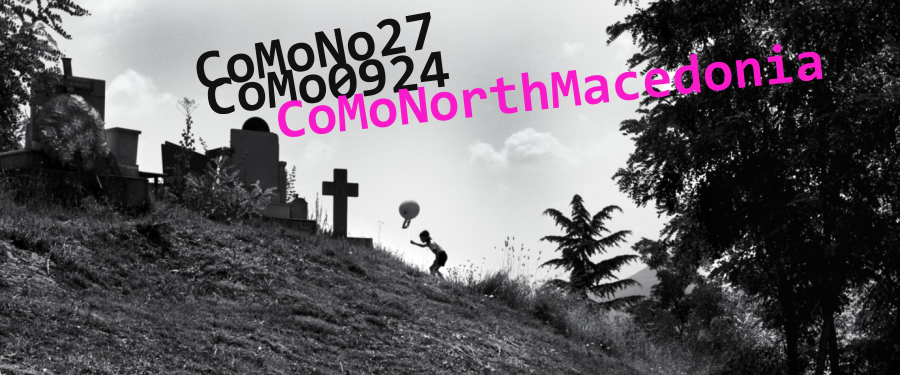
CoMo No. 27: North Macedonia (September, 2024)
- Holdrüholoheuho
- Posts: 3200
- Joined: Sat Sep 05, 2020 12:30 am
- Location: Prague, Bohemia
revisiting CoMoHellada, this (past) entry about Manaki bros ↓↓ can be the starting point (i guess)
btw. the initial film still ↑↑ is from “Bardo”(2012) by Marija Apčevska (a short that seems to be out of reach) and has been haphazardly appropriated while looking into this list: CINEMA OF NORTH MACEDONIA → https://mubi.com/en/lists/macedonian-ci ... 3977b0a8e5 (hello, Mario!)der kulterer wrote: ↑Thu May 25, 2023 10:09 am GRANDMA DESPINA (Janaki Manaki, Milton Manaki, 1905) #CoMoΕλλάδα
Meanwhile, in 1905 in Macedonia, the brothers Yannakis (Ioannis) (1878–1954) and Miltiadis (1882–1964) Manaki recorded rural scenes from the life of ordinary villagers. They made a number of reels, which established the genre of ethnographic documentary in the Balkans, despite their disputed political agenda. Macedonia was a contested area that still belonged to the collapsing Ottoman Empire, but Greece, Serbia, and Bulgaria aspired to annex it to their national territories.
The Manaki brothers produced films that depicted the ethnic diversity of the region as well as the strange in-between minorities that had escaped the attention of the political rivals. These included work on the Aromanian Vlachs, Macedonian Slavs and the Romas. Christos Christodoulou has observed that, “The Manaki Brothers . . . recorded the Balkans at some of their most critical historical moments with both touching impartiality and a sense of documentary precision.”
The documentaries of the Maniaki Brothers do not belong to a single national cinema. They constitute the “primary foundational texts” of the
whole cinematography that was to evolve with the collapse of the Ottoman Empire after the First World War. The lives of the two brothers are equally telling. One died poor and unknown in Thessalonica in 1954, while the other was celebrated as a national hero in Yugoslavia, with each of them opting for a different motherland, a different identity, and a different culture.
-
Mario Gaborovic
- Posts: 252
- Joined: Fri Jan 04, 2019 8:54 am
I'll first give some intro to the culture, since I guess it's all the same to the West; or any other foreigners, for that matter.
Macedonia was the poorest exYU republic in terms of economy (with only Kosovo trailing, but that was only a province back then), which is why their cinematic output was somewhat limited. Today, out of 2 million people, around 25% are ethnic Albanians. They're mostly living in the west chunk of the country; other significant minorities include Roma, Serbs and Turks.
The main export products are tobacco and peppers. It's also the sunniest and hence driest exYU region, which reflected on the flag; some used to say, "the land of eternal sun". The language is somewhat middle-way between Serbian and Bulgarian, but closer to the latter. Bulgaria has significant ties with his tiny neighbor, and tried to assimilate and claim their territory numerous times. While Macedonians surnames usually end in -ski, Bulgarian end in -ov. Macedonians are Orthodox Christians.
Ok,so throughout most of its history (which is very rich) the life here was hard, due to drought and poverty. Hence many of Macedonians live abroad, Australia in particular where their largest community is. The landscape is mostly hilly, yellowish and there's a few big lakes in the south. These are most frequently visited tourist destinations, besides capital Skopje.
Their national music is a genuine Balkan sound, with their instruments known as "Zurna" most prominent. If we talk about rock/alternative music, they had pretty vibrant goth rock scene in the 1980s. One darkwave band influenced the other, I guess that's how it triggered the whole thing. However, their biggest and most commercial act, was a prog rock band "Leb i sol" (Bread and Salt).
Film-wise, they made a start pretty early on just because of those two Aromanians (Greeks who were latinized, basically, which is why the most mixed them with Romanians back then). They had some photography shop in Bitola (2nd largest town, after Skopje), but after they call it quit, only a few films were made before the WW2.
After the WW2, the largest company was "Vardar Film"; Vardar is the largest river in the country, and also the best known football club bears its name. Since the 1990s independence, just like elsewhere in the East Europe, countless little production companies were established. Surprisingly, there was also some animation filmmaking there (albeit Croatian school of animation was No.1 in that regard).
In Yugoslavia, the best known actor was Meto Jovanovski (1946-2023). After independence, I guess most would recognize Labina Mitevska (1975-).
Starter pack, if you ask Mario:
--------------------------------------------------------------------------
Galička svadba AKA The Galichnik Wedding (1955) - short
Planinata na gnevot AKA The Mountain of Wrath (1968)
Kolnati sme, Irina AKA We're Cursed, Irene (1973)
Tetoviranje AKA Tattoo (1991)
Pre kiše AKA Before the Rain (1994)
Medena zemja AKA Honeyland (2019)
Macedonia was the poorest exYU republic in terms of economy (with only Kosovo trailing, but that was only a province back then), which is why their cinematic output was somewhat limited. Today, out of 2 million people, around 25% are ethnic Albanians. They're mostly living in the west chunk of the country; other significant minorities include Roma, Serbs and Turks.
The main export products are tobacco and peppers. It's also the sunniest and hence driest exYU region, which reflected on the flag; some used to say, "the land of eternal sun". The language is somewhat middle-way between Serbian and Bulgarian, but closer to the latter. Bulgaria has significant ties with his tiny neighbor, and tried to assimilate and claim their territory numerous times. While Macedonians surnames usually end in -ski, Bulgarian end in -ov. Macedonians are Orthodox Christians.
Ok,so throughout most of its history (which is very rich) the life here was hard, due to drought and poverty. Hence many of Macedonians live abroad, Australia in particular where their largest community is. The landscape is mostly hilly, yellowish and there's a few big lakes in the south. These are most frequently visited tourist destinations, besides capital Skopje.
Their national music is a genuine Balkan sound, with their instruments known as "Zurna" most prominent. If we talk about rock/alternative music, they had pretty vibrant goth rock scene in the 1980s. One darkwave band influenced the other, I guess that's how it triggered the whole thing. However, their biggest and most commercial act, was a prog rock band "Leb i sol" (Bread and Salt).
Film-wise, they made a start pretty early on just because of those two Aromanians (Greeks who were latinized, basically, which is why the most mixed them with Romanians back then). They had some photography shop in Bitola (2nd largest town, after Skopje), but after they call it quit, only a few films were made before the WW2.
After the WW2, the largest company was "Vardar Film"; Vardar is the largest river in the country, and also the best known football club bears its name. Since the 1990s independence, just like elsewhere in the East Europe, countless little production companies were established. Surprisingly, there was also some animation filmmaking there (albeit Croatian school of animation was No.1 in that regard).
In Yugoslavia, the best known actor was Meto Jovanovski (1946-2023). After independence, I guess most would recognize Labina Mitevska (1975-).
Starter pack, if you ask Mario:
--------------------------------------------------------------------------
Galička svadba AKA The Galichnik Wedding (1955) - short
Planinata na gnevot AKA The Mountain of Wrath (1968)
Kolnati sme, Irina AKA We're Cursed, Irene (1973)
Tetoviranje AKA Tattoo (1991)
Pre kiše AKA Before the Rain (1994)
Medena zemja AKA Honeyland (2019)
- Holdrüholoheuho
- Posts: 3200
- Joined: Sat Sep 05, 2020 12:30 am
- Location: Prague, Bohemia
thanks! Medena zemja AKA Honeyland (2019) already on my watchlist, will check the others too.
Labina Mitevska became well-known here due to acting in “Loners” → https://letterboxd.com/film/loners/ (a local generational cult classic — for some strange/dumb reason).
the same way i ”exploited” CoMoSlovenia to investigate Olmo Omerzu, during this CoMo i plan to take a closer look at Skopje-born (active in Bohemia, FAMU graduate, now he teaches film editing at FAMU) Ivo Trajkov → https://letterboxd.com/director/ivo-trajkov/
since the 1970 poll is still in fresh memory and “Ear” (Kachyňa) was doing well, maybe someone will be curious to hear that Ivo Trajkov shot a remake of this film called “Honey Night” (2015) — he transposed the story from 1960s Czechoslovakia to 1990s Macedonia → https://letterboxd.com/film/honey-night/ (will definitely watch and report).
Labina Mitevska became well-known here due to acting in “Loners” → https://letterboxd.com/film/loners/ (a local generational cult classic — for some strange/dumb reason).
the same way i ”exploited” CoMoSlovenia to investigate Olmo Omerzu, during this CoMo i plan to take a closer look at Skopje-born (active in Bohemia, FAMU graduate, now he teaches film editing at FAMU) Ivo Trajkov → https://letterboxd.com/director/ivo-trajkov/
since the 1970 poll is still in fresh memory and “Ear” (Kachyňa) was doing well, maybe someone will be curious to hear that Ivo Trajkov shot a remake of this film called “Honey Night” (2015) — he transposed the story from 1960s Czechoslovakia to 1990s Macedonia → https://letterboxd.com/film/honey-night/ (will definitely watch and report).







tatko (father)/we're cursed, irina (angelovski 1973) - macedonia looks like a beautiful wild place. they were indeed cursed
-
Mario Gaborovic
- Posts: 252
- Joined: Fri Jan 04, 2019 8:54 am
Pateka AKA The Road (1967)
Excellent arthouse short by Ljubiša Georgievski. No dialogue.
https://letterboxd.com/film/the-path-1967/
Excellent arthouse short by Ljubiša Georgievski. No dialogue.
https://letterboxd.com/film/the-path-1967/
I've seen a fair number of Macedonian movies. They tend to be pretty dark. Dark... and stony. Aside from aforementioned WE'RE CURSED, IRINA these ones I like:
The Price of a Town (L. Georgievski, 1970)
Mountain of Wrath (Georgievski, 1968)
Under the Same Sky (Georgievski & Stamenković, 1964)
Three Girls Named Anna (B. Bauer, 1959)
Days of Temptation (B. Gapo, 1965)
Times without War (Gapo, 1969)
Macedonian Saga (Gapo, 1993)
Mother (S. Popov, 1979)
Times, Waters (Popov, 1980)
The Red Horse (Popov, 1981)
Happy New Year '49 (Popov, 1986)
Would see if I had more time: A Quiet Summer & Memento (D. Osmanli); Frosina (V. Nanovic); Bloodshed at the Wedding (T. Popov)
The Price of a Town (L. Georgievski, 1970)
Mountain of Wrath (Georgievski, 1968)
Under the Same Sky (Georgievski & Stamenković, 1964)
Three Girls Named Anna (B. Bauer, 1959)
Days of Temptation (B. Gapo, 1965)
Times without War (Gapo, 1969)
Macedonian Saga (Gapo, 1993)
Mother (S. Popov, 1979)
Times, Waters (Popov, 1980)
The Red Horse (Popov, 1981)
Happy New Year '49 (Popov, 1986)
Would see if I had more time: A Quiet Summer & Memento (D. Osmanli); Frosina (V. Nanovic); Bloodshed at the Wedding (T. Popov)
Have a look at all the picnics of the intellect: These conceptions! These discoveries! Perspectives! Subtleties! Publications! Congresses! Discussions! Institutes! Universities! Yet: one senses nothing but stupidity. - Gombrowicz, Diary
- Holdrüholoheuho
- Posts: 3200
- Joined: Sat Sep 05, 2020 12:30 am
- Location: Prague, Bohemia
i logged in the past few years...
Grandma Despina (Janaki Manaki, Milton Manaki, 1905, 1m) ... viz above
Dervishes (Aco Petrovski, 1955, 11m) ... in a better quality on KG
Sic Transit Gloria Mundi / Heraclea (Ljubiša Georgievski, 1974, 10m)
now, the first viewings...
Celebration of Epiphany in Bitola (Janaki Manaki, Milton Manaki, 1905, 1m) #CoMoNoMa
City Wedding (Janaki Manaki, Milton Manaki, 1905, 1m) #CoMoNoMa ... a very posh wedding with a lot of cars
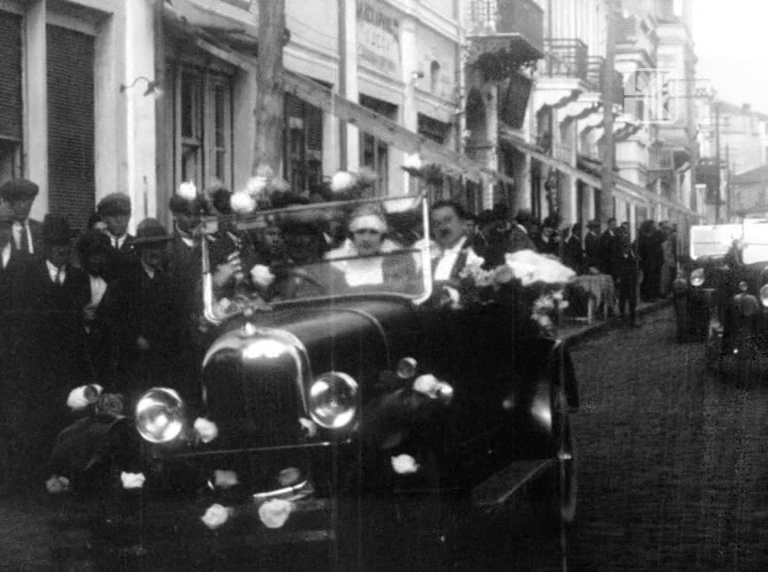
Funeral in Bitola (Janaki Manaki, Milton Manaki, 1905, 1m) #CoMoNoMa
The Celebration with Slogans in Greek (Janaki Manaki, Milton Manaki, 1908, 1m) #CoMoNoMa
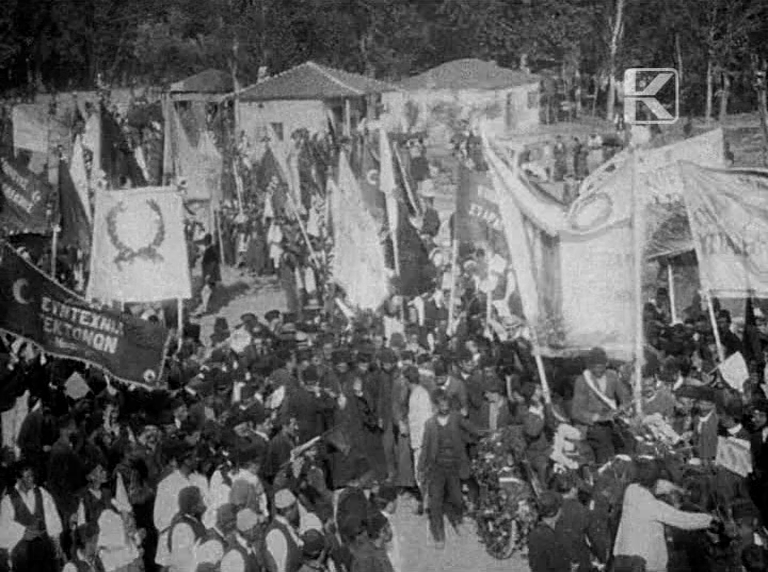
Grandma Despina (Janaki Manaki, Milton Manaki, 1905, 1m) ... viz above
Dervishes (Aco Petrovski, 1955, 11m) ... in a better quality on KG
Sic Transit Gloria Mundi / Heraclea (Ljubiša Georgievski, 1974, 10m)
The Path (Ljubiša Georgievski, 1967, 11m) .. viz aboveThe film introduces the history of one of the oldest towns in Macedonia: Heraklea Linkestis, which was built in the 4th century B.C.
now, the first viewings...
Celebration of Epiphany in Bitola (Janaki Manaki, Milton Manaki, 1905, 1m) #CoMoNoMa
City Wedding (Janaki Manaki, Milton Manaki, 1905, 1m) #CoMoNoMa ... a very posh wedding with a lot of cars

Funeral in Bitola (Janaki Manaki, Milton Manaki, 1905, 1m) #CoMoNoMa
The Celebration with Slogans in Greek (Janaki Manaki, Milton Manaki, 1908, 1m) #CoMoNoMa

- Holdrüholoheuho
- Posts: 3200
- Joined: Sat Sep 05, 2020 12:30 am
- Location: Prague, Bohemia
(just reading) about something completely different...
Reconstruction Plan for Skopje → https://architectuul.com/architecture/r ... for-skopje
How an earthquake brought Kenzo Tange to Skopje → https://www.greyscape.com/how-an-earthq ... to-skopje/
Modernist Heritage: The Global Architecture Initiative that Rebuilt Post-Earthquake Skopje → https://architizer.com/blog/inspiration ... arthquake/
Reconstruction of Skopje 1963 → https://en.wikipedia.org/wiki/Reconstru ... kopje_1963In January 1965, Kenzo Tange received a telegram from the United Nations asking if he would be interested in participating in an international planning competition for the reconstruction of Skopje, the regional capital of the Yugoslav Republic of Macedonia. A severe earthquake hit the city in July 1963, killing more than 2,000 people and destroying roughly 65 percent of the buildings in the city.
...
Tange's plan played an important role in guiding the process of Skopje's reconstruction, which was a remarkable success in terms of its efficiency and international cooperation. The city soon regained its vitality and enjoyed an economic boom. Under the guidelines framed by the planning team, the new buildings tended to be "progressive" in design style, a tone set by Tange's response to the demand of "a new architecture for a new revolutionary society."
Reconstruction Plan for Skopje → https://architectuul.com/architecture/r ... for-skopje
How an earthquake brought Kenzo Tange to Skopje → https://www.greyscape.com/how-an-earthq ... to-skopje/
Modernist Heritage: The Global Architecture Initiative that Rebuilt Post-Earthquake Skopje → https://architizer.com/blog/inspiration ... arthquake/
-
Mario Gaborovic
- Posts: 252
- Joined: Fri Jan 04, 2019 8:54 am
Yeah the 1963 Skopje earthquake was most fatal in the history of exYU (1070 dead). Two docs exist about it, one old and one rather fresh:
https://www.imdb.com/title/tt0326165/
https://www.imdb.com/title/tt11821932/
https://www.imdb.com/title/tt0326165/
https://www.imdb.com/title/tt11821932/
- Holdrüholoheuho
- Posts: 3200
- Joined: Sat Sep 05, 2020 12:30 am
- Location: Prague, Bohemia
the need of subs limits me but i tried this one without.Mario Gaborovic wrote: ↑Fri Sep 06, 2024 12:34 pm Two docs exist about it, one old
https://www.imdb.com/title/tt0326165/
Skopje '63 (Veljko Bulajić, 1964) #CoMoNoMa
this documentary is framed as a film within a film (the crew presenting the movie to the locals)The filming started three days after the earthquake and lasted for four months. After that, Bulajić spent 12 months editing the footage
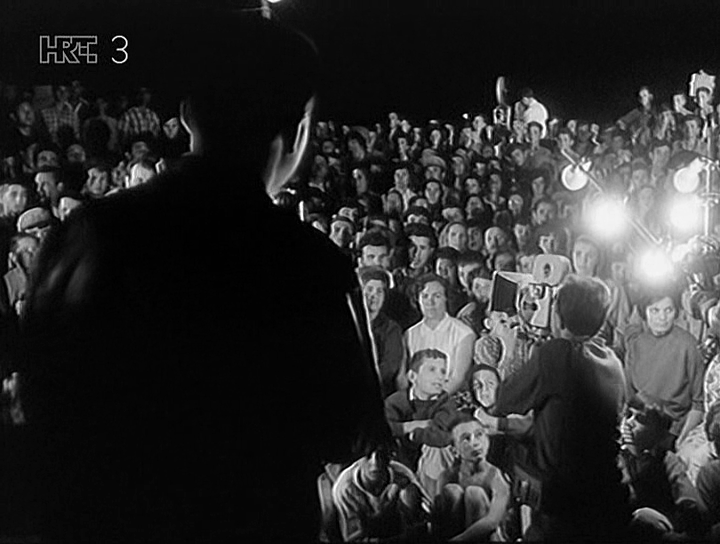
screening starts with the archival footage of the pre-earthquake Skopje.
but it's getting interrupted whenever anyone (from the audience) recognizes someone who is not anymore (the film is stopped and the viewer specifies some details to the crew and the rest of the audience).
later, we (for example) see a scene of a mourning person and, in the next shot, we see in the auditorium the same person watching the film (i.e. a person watching himself on screen).
so, it's not just a documentary presenting a (significant) subject matter but there is an ongoing conscious effort to be (formally) inventive in the way the subject matter is presented.
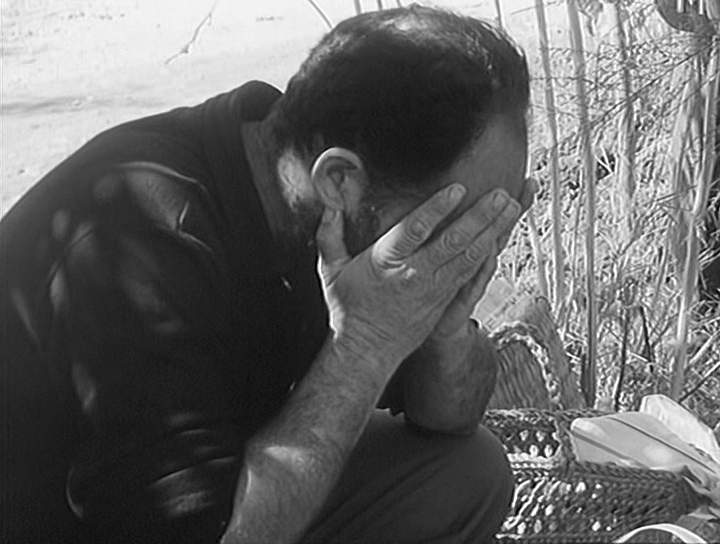
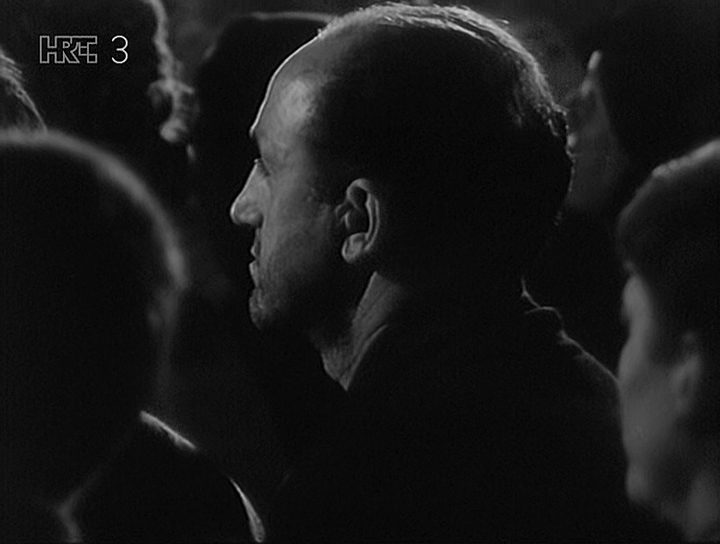
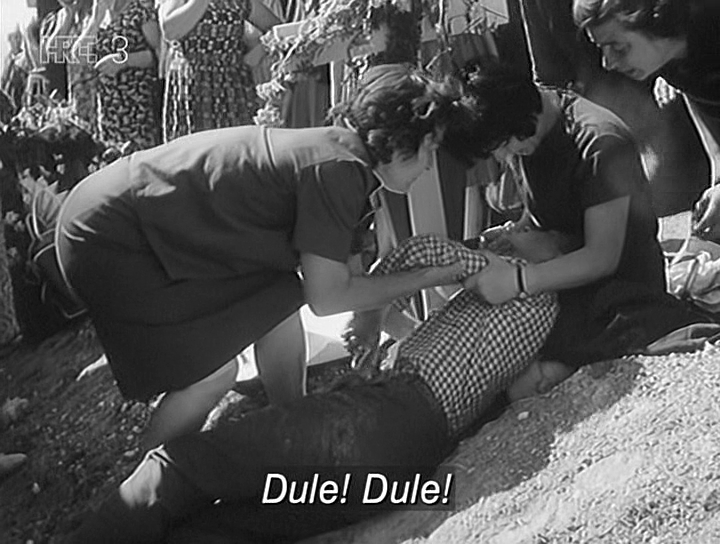
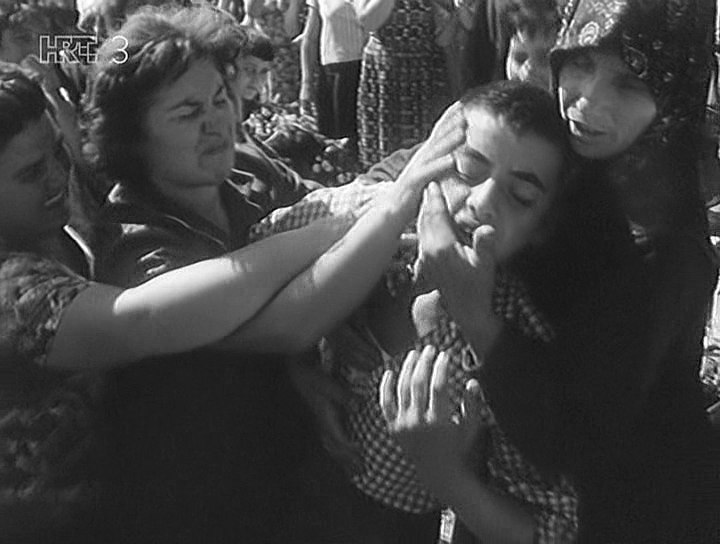

once the film roll is found in the destroyed car in front of the hotel, the pre-earthquake vacation (captured on the roll) is shown in inverted colors (undeveloped).

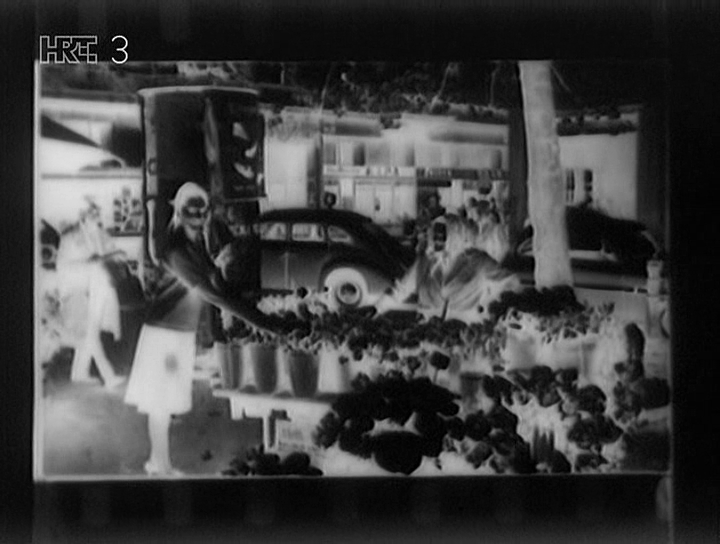
quite impactful is also a series of dystopic shots containing various public clocks, showing the moment when the time stopped.
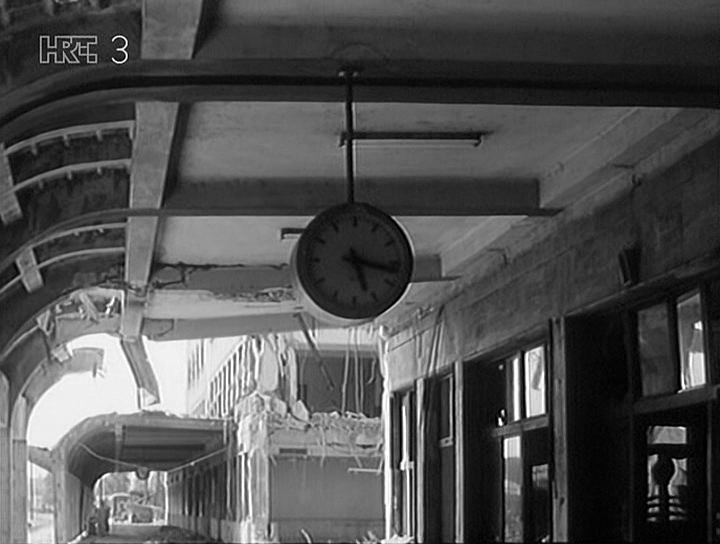
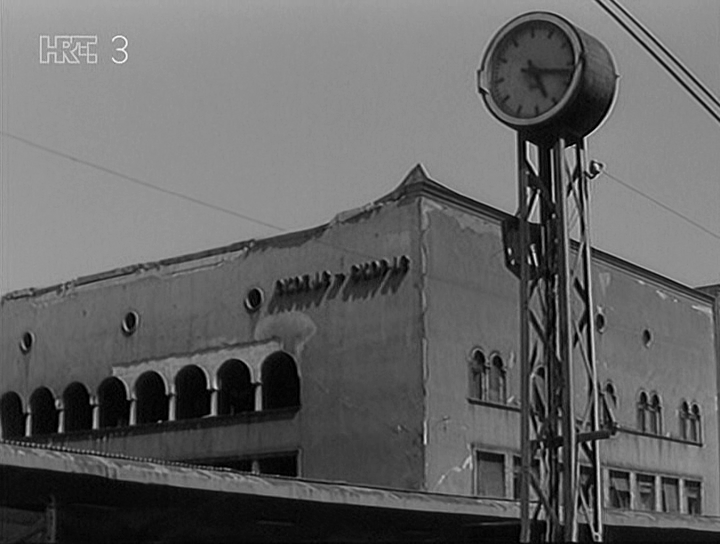
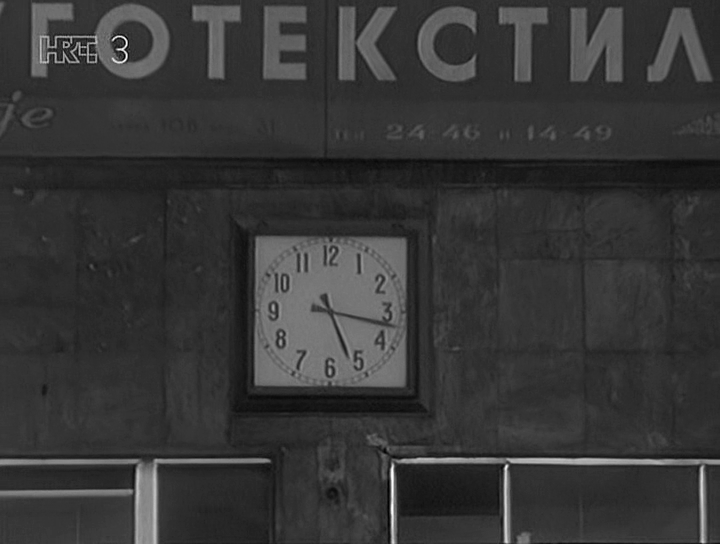
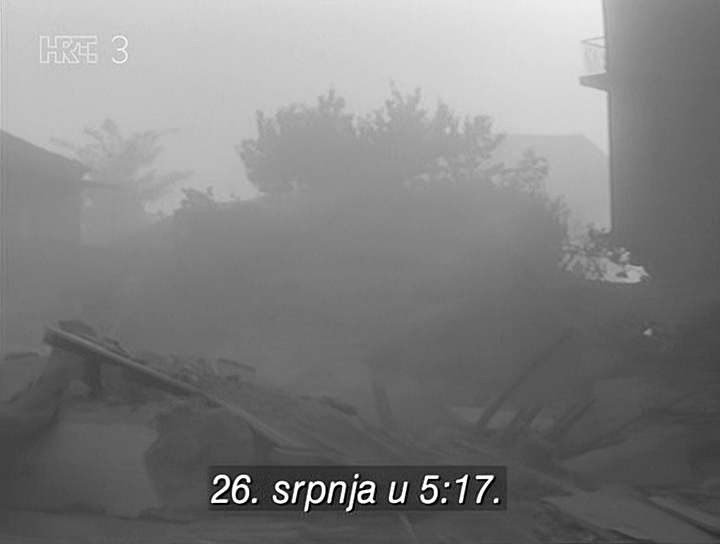
while the life departed the city in the coffins...
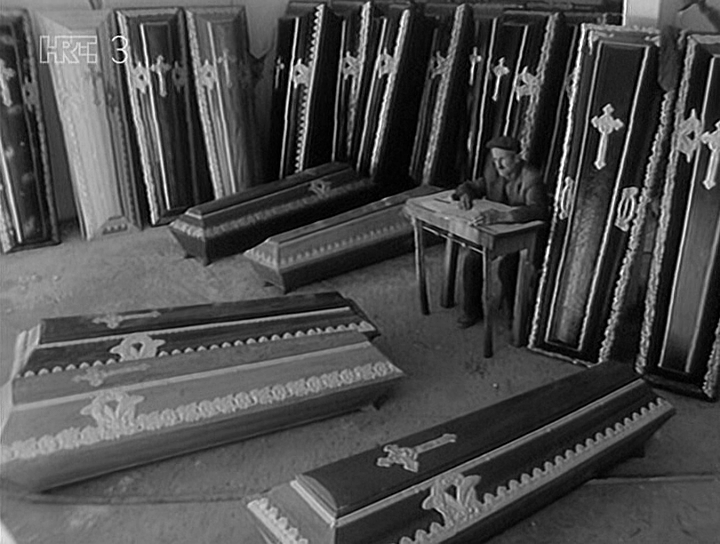
... it returned to the city on bicycles (a lot of bicycles!).
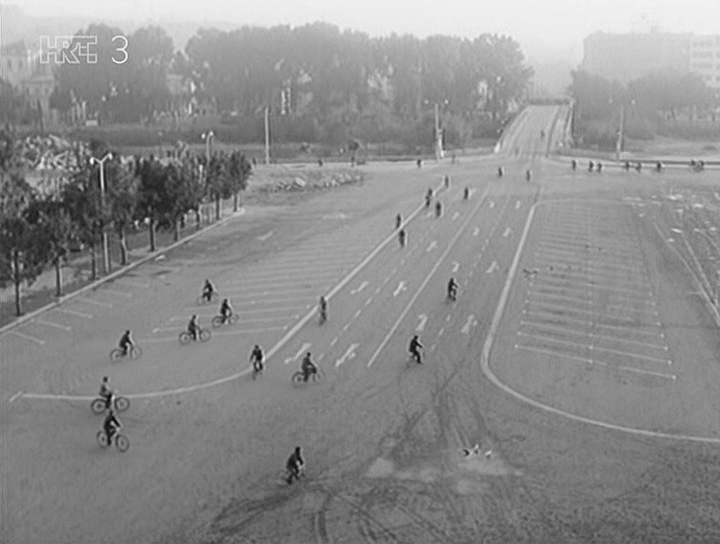
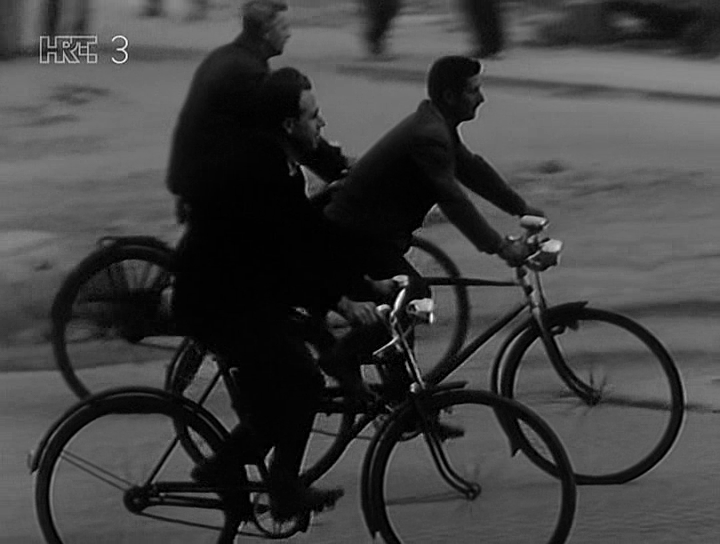
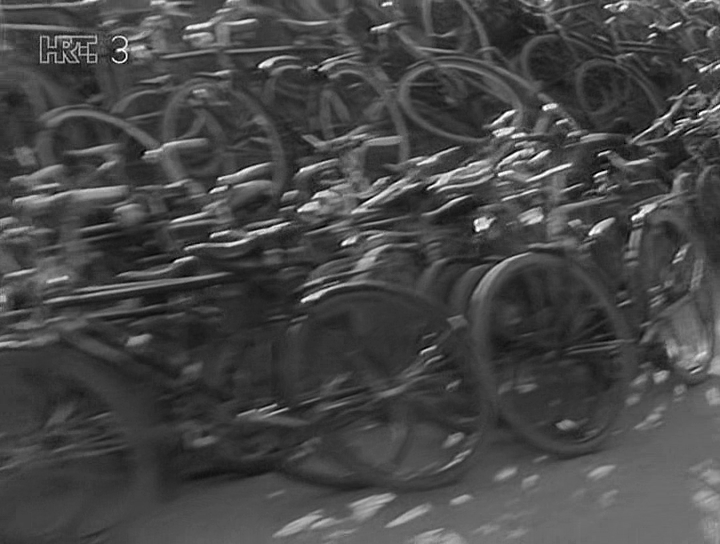
ode to human resilience (solidarity & tireless collective efforts can even unshake the earthquake).
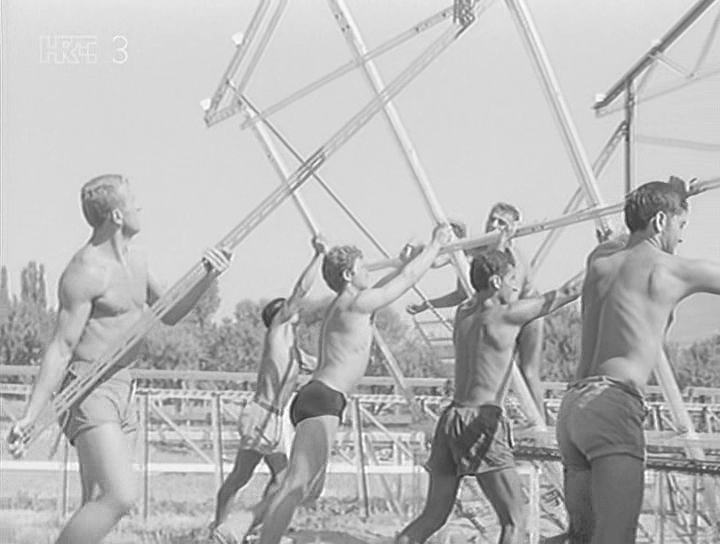
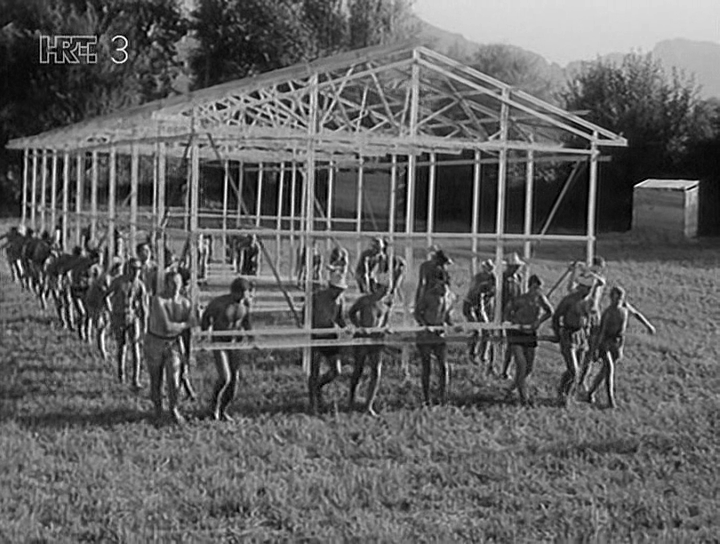
screening (within the film) ends and we (the viewers of the whole documentary) witness the discussion of the filmmakers with the audience.
this was the only part i really missed the subtitles (i didn't grasp enough words to follow), so i can't say what opinions or remarks the audience expressed.
despite this little flaw (caused by the language barrier — not the flaw of the film itself), my opinion of the film is positive (it's worth watching even without subtitles!).
-
Mario Gaborovic
- Posts: 252
- Joined: Fri Jan 04, 2019 8:54 am
I found the most disturbing shot to be the one with a family tombstone. You can clearly see a three-year-old girl at the right. So heartbreaking.
It was totally unexpected and caught them off-guard, as it occurred around 4am. Imagine the horror.
It was totally unexpected and caught them off-guard, as it occurred around 4am. Imagine the horror.
- Holdrüholoheuho
- Posts: 3200
- Joined: Sat Sep 05, 2020 12:30 am
- Location: Prague, Bohemia
when the pre-earthquake sequence ends with a news anchor reading (rather trivial) occurrences of the day and then wishing the (then) viewers/listeners "have a good night!" (while we (now) know what is going to happen early morning) it sounds truly sinister.
-----------------------
while, in the previous ↑↑ documentary, the clocks stop due to time getting mortified, in the next animation ↓↓, the clocks stand still (at the beginning of time), awaiting to start counting down the lifespan.
Adam (5 to 12) (Petar Gligorovski, 1977) #CoMoNoMa
also, there is no way back to Adamites or Neo-Adamites → https://en.wikipedia.org/wiki/Adamites
one has to develop & build up a coherent frame of thought (a solid foundation for a bright future).
Embryo No. M (Petar Gligorovski, 1971) #CoMoNoMa
-----------------------
while, in the previous ↑↑ documentary, the clocks stop due to time getting mortified, in the next animation ↓↓, the clocks stand still (at the beginning of time), awaiting to start counting down the lifespan.
Adam (5 to 12) (Petar Gligorovski, 1977) #CoMoNoMa
yeah, it's not possible to stay forever in an embryonic (Adamite) state!
also, there is no way back to Adamites or Neo-Adamites → https://en.wikipedia.org/wiki/Adamites
one has to develop & build up a coherent frame of thought (a solid foundation for a bright future).
Embryo No. M (Petar Gligorovski, 1971) #CoMoNoMa
- Holdrüholoheuho
- Posts: 3200
- Joined: Sat Sep 05, 2020 12:30 am
- Location: Prague, Bohemia
- Holdrüholoheuho
- Posts: 3200
- Joined: Sat Sep 05, 2020 12:30 am
- Location: Prague, Bohemia
The Birds Are Coming (Branko Gapo, 1956) #CoMoNoMaThe Dojran Lake → https://en.wikipedia.org/wiki/Doiran_Lake is known for its traditional way of fishing with the help of birds in reed fences, the so-called mandras. This is one of the few places in the world where fish are hunted with birds. Mandra is a water area near the shore, which has a fishing house, and on the three sides it is enclosed with reed. Preparations for fishing in this old traditional way begin in October and last until March. In October the two sides are enclosed by the reed, and the side to Dojran Lake is left open. When the cormorants come during November, seeking food they approach the fence, chasing the fish in that direction. Fishermen, when they conclude that there is enough fish, also build the third part of the mandra from Dojran Lake. They catch the birds in a section called pilikatnik, they cut their wings and release them to the fence at the lake, which does not allow the fish to get out of the enclosure. Birds with cut wings are called argati. As time passes, the fence becomes more narrow and approaches the shore, creating a small area called kotec from where the fish are drawn.
when you write an elaborate script because you intend to make an elaborate 1+ hour-long docudrama...
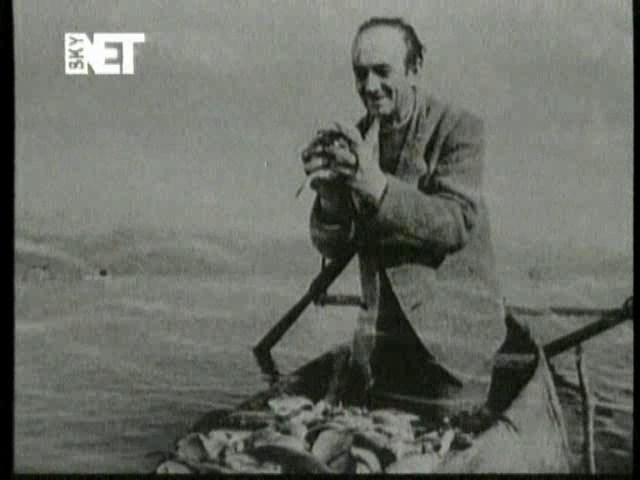
... but obtain only a 17 minutes-long film roll...
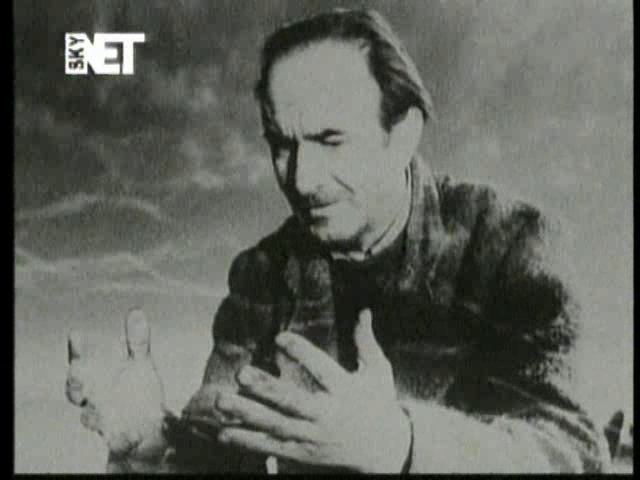
... it's a disappointment & dilemma but then you decide, "fuck it, i'm gonna say E-V-E-R-Y-T-H-I-N-G anyway!"

- Holdrüholoheuho
- Posts: 3200
- Joined: Sat Sep 05, 2020 12:30 am
- Location: Prague, Bohemia
Frosina (Vojislav Nanović, 1952) #CoMoNoMa
Frosina is one of the many Macedonian wives whose husbands are economic emigrants abroad.
Marriage does not bring them a family, only the burden of life itself. After her husband's short visits, she gives birth to children who do not live long because of the poverty into which they have been born. She gives birth to them alone, and she buries them alone. Only her last child, Klime, survives all his various illnesses and grows up to be her one joy in life.
The war breaks out...
- Holdrüholoheuho
- Posts: 3200
- Joined: Sat Sep 05, 2020 12:30 am
- Location: Prague, Bohemia
Honey Night (Ivo Trajkov, 2015) #CoMoNoMader kulterer wrote: ↑Tue Sep 03, 2024 8:34 pm during this CoMo i plan to take a closer look at Skopje-born (active in Bohemia, FAMU graduate, now he teaches film editing at FAMU) Ivo Trajkov → https://letterboxd.com/director/ivo-trajkov/
since the 1970 poll is still in fresh memory and “Ear” (Kachyňa) was doing well, maybe someone will be curious to hear that Ivo Trajkov shot a remake of this film called “Honey Night” (2015) — he transposed the story from 1960s Czechoslovakia to 1990s Macedonia → https://letterboxd.com/film/honey-night/ (will definitely watch and report).
i watched the Kachyňa's classic (that i adore) long ago, so i can't make detailed comparisons but overall (plot-wise) it is very similar.
thus, this new adaptation (of the short story by Jan Procházka) does not offer any new (& unexpected) take (by variating the narrative), rather it shows the very same story can be told in a very different setting (suggesting the different regimes use similar methods).
in reviews, one can read that (despite all the similarities) this (Macedonian) version has a different ending (more true to the book).
i observed only a minor extension.
both (Czech & Macedonian) heroes (after spending a sleepless night filled with paranoia & expecting the arrest) get (contrary to their expectations) promoted (become ministers — replacing the arrested ministers with whom they closely collaborated before).
while it's the end of the Czech 1960s tale, the Macedonian 1990s tale proceeds a bit more and the hero truly enters the ministerial office and finds on the desk the key kompromat (that he was looking for the whole night to destroy it) — thus it is even more clear that despite promotion "they" know, and he knows they know, and they know he knows they know, etc., etc., etc.
also, i learned (while reading other reviews) that it's actually a third film rendering of the story.
besides the original by Kachyňa and this one by Trajkov, there is also an adaptation (called "Ear" AKA "Das Ohr") made for the Austrian TV by Pavel Kohout in 1983 → https://www.imdb.com/title/tt21654002/
Pavel Kohout was a youthful Stalinist, who later (during the Prague Spring) supported liberalization, and ended up (after the Kremlin invasion) in anti-communist dissent (and ultimately in Austrian exile).
- Holdrüholoheuho
- Posts: 3200
- Joined: Sat Sep 05, 2020 12:30 am
- Location: Prague, Bohemia
The Troubles of the Deceased K.K. (Zdravko Velimirović, 1963) #CoMoNoMa
something between Kafkaesque satire on bureaucracy and a traffic safety video.
something between Kafkaesque satire on bureaucracy and a traffic safety video.
The unexpected death
of the unimportant and modest clerk, Krste Krstevski,
who lived as a bachelor in rented accommodation all his life, surprises his colleagues and acquaintances.
It is only now that he can get his revenge for the minor intrigues, it can be said even that his true life begins after his death.

In the attitude of the authors, one can sometimes feel the unsparing sting of the ironic commentary, which seems to adapt the situations to itself instead of springing from them. Considering that this is the first genre attempt to create such a jest, obvious discrepancies are observed in the style and intonation of the commentary, as well as in the style and atmosphere of the action played, which contributes to the formation of the general impression of a somewhat forced symbolism. However, the sharp satirical tone directed at the phenomenon of bureaucratic evil (present mostly in the spoken commentary), undoubtedly achieves a certain humorous effect.
- Holdrüholoheuho
- Posts: 3200
- Joined: Sat Sep 05, 2020 12:30 am
- Location: Prague, Bohemia
The Resistance (Boro Pejčinov, 1978) #CoMoNoMa
a heroic tale!
a heroic tale!
- Holdrüholoheuho
- Posts: 3200
- Joined: Sat Sep 05, 2020 12:30 am
- Location: Prague, Bohemia
Monument (Veljo Lichenoski, 1968) #CoMoNoMa
an ode to the hard labor of building a personality cult!!
Darko Damevski (borrowed for the main role & playing all the main characters) was absolutely stunning (i can't aggrandize his acting mastery enough)!!!
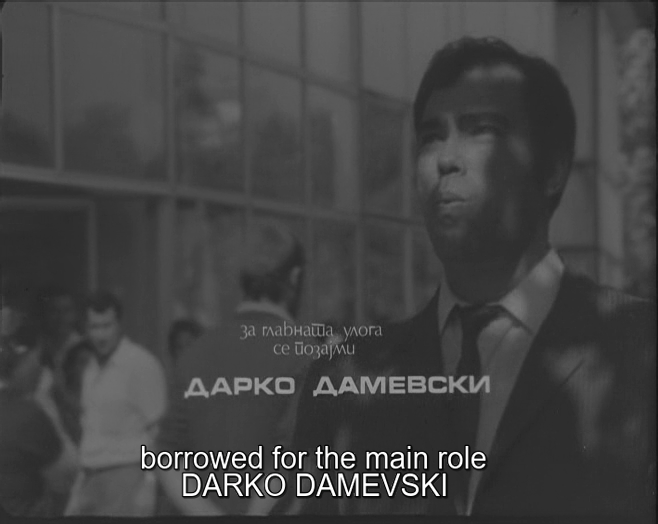
loved "Path" and love "Monument" too, "Vardar-Film" was on fire then!The solid scope of this film (Ljubisha Georgievski’s The Path), in a certain way, repeats itself in the next short feature film by "Vardar-Film" - "Monument" filmed in 1968. We can count this work among the cinematic grotesques, even though its formal, external elements do not imply that at first glance.
an ode to the hard labor of building a personality cult!!
Darko Damevski (borrowed for the main role & playing all the main characters) was absolutely stunning (i can't aggrandize his acting mastery enough)!!!

A well-dressed citizen,
who does not differ in any way from other people in our everyday life,
is looking for a suitable space around the city for some kind of project.
He soon finds it between two large buildings.
In that space, he measures and plans something with geometers and technicians. Then a truck pulls up and a large pile of various books and notebooks, folders and paper is unloaded from it... All this will serve our hero to build some sort of pedestal. He shapes it very carefully and when he is near the end, he saws a large notebook so that it does not go out of the strictly measured zone.
The pedestal is finally finished,
the morning dawns with a covered figure, and it becomes clear that it is a memorial object. Citizens gather to attend its grand unveiling. Through the expressionless and mostly indifferent faces of the crowd, we notice that they are watching a speech held in front of the monument by a socio-political worker,
in whom we recognize the same citizen or "hero" from the beginning of the film. Suddenly, we notice his character both as a radio reporter and as a TV cameraman and as a man from the audience.
His multiplicity becomes apparent and culminates in the unveiling of the monument,
where he represents a statue in an ancient pose covered with a white toga. His double is still standing under the monument, trying to assume the same pose as the "statue". The film ends with this shot and with a text that can be understood as both a slogan and a proclamation or warning — "Attention! For those who did not attend, I will reveal myself again tomorrow!"
"
- Holdrüholoheuho
- Posts: 3200
- Joined: Sat Sep 05, 2020 12:30 am
- Location: Prague, Bohemia
Love Story (Delco Mihajlov, 1982) #CoMoNoMa
it was supposed to be a "love story" and instead i got a silly anti-capitalist & anti-drinking agitprop.
now, i feel exploited by Vardar-Film.A man enters a bar. Near him, there sits a woman. He gets closer to her drinking the string of glasses that lead to her and when he drinks the last one falls drunk on the ground. At this point, we notice it’s just a doll, a bite for the customer. Our world is commercialized to the extent that all means are to make profits.
it was supposed to be a "love story" and instead i got a silly anti-capitalist & anti-drinking agitprop.
- Holdrüholoheuho
- Posts: 3200
- Joined: Sat Sep 05, 2020 12:30 am
- Location: Prague, Bohemia
The Great Water (Ivo Trajkov, 2004) #CoMoNoMa
(and the bust of comrade Stalin gets disgraced & desecrated as a result)
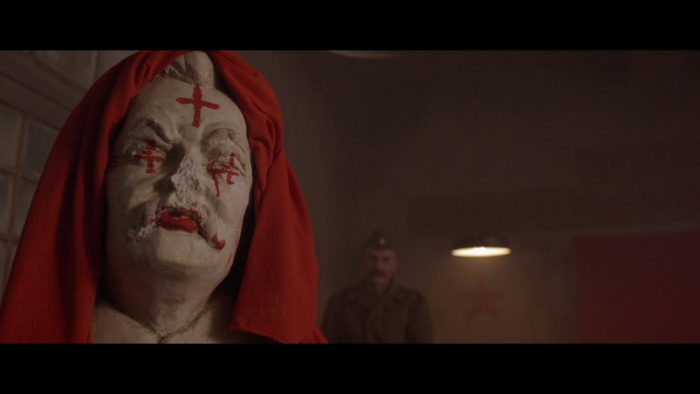
Živko Čingo → https://en.wikipedia.org/wiki/%C5%BDivko_%C4%8CingoBased on a book written by Živko Čingo in the 1970s
In present-day Macedonia, a very successful politician Lem Nikodinoski is rushed to the emergency room. During his near-death experience, he goes back to his childhood at the age of twelve. World War II has just ended. Young Lem, like so many war orphans, wanders aimlessly through the countryside only to be caught by communist soldiers. He is taken to the children’s orphanage, in fact, an “ideological” labor camp where kids are brought to be ideologically “reprogrammed.” This is where his true hardship begins. One day a mysterious boy is brought to the orphanage and Lem’s life changes forever.
Stalinist brainwashing in a post-WW2 youth detention camp meets magic realismThe story is told through the memories of Lem, who, on his deathbed, recalls his life as a 12-year-old living in an orphanage after World War II. The orphanage, for children of ‘fallen enemies’, was actually more of a juvenile detention center where the iron fist of discipline reigned. But when 13-year-old Isak, a special boy with mystical abilities, arrives, everyone knows he will be the one to break the routine. After winning Isak’s friendship through a series of difficult trials, Lem and Isak share adventures, and, above all, wage war on their adult oppressors. But when one of their exploits results in tragedy, it leads to a betrayal so great that even the dying Lem can’t find forgiveness…
(and the bust of comrade Stalin gets disgraced & desecrated as a result)

https://www.researchgate.net/publicatio ... IVKO_CINGO
NUANCE OF ANIMISM IN THE PROSE OF ŽIVKO ČINGO
(by Danijela Kostadinović, August 2020)
With a narrative process based on folklore patterns, mythical-magical and archetypal images and plays, Živko Čingo depicts the period after the Second World War in Macedonia, marked by the differentiation of two dialectics that try to control each other: communist utopias and Pagan-Christian mystics. Although the new communist world seeks to destroy the old traditional religious system violently, it hovers over it like a shadow, penetrating all its pores, since archetypes have a strong energy potential of the past and memory and take place on an impulsive and instinctive, collectively unconscious level.
- Holdrüholoheuho
- Posts: 3200
- Joined: Sat Sep 05, 2020 12:30 am
- Location: Prague, Bohemia
-
Mario Gaborovic
- Posts: 252
- Joined: Fri Jan 04, 2019 8:54 am
Now a music video, showing rich legacy of Darkwave sound in Macedonia.
- Holdrüholoheuho
- Posts: 3200
- Joined: Sat Sep 05, 2020 12:30 am
- Location: Prague, Bohemia
The Past (Ivo Trajkov, 1998) #CoMoNoMa
Using a pure film language, writer-director Ivo Trajkov explores the story of a deaf man driven through desperation to commit murder. Upon being released from jail he begins to search for his beloved but is hindered in his efforts by his handicap.
Thanks to the consistently mute stylization, the film succeeds in very vividly allowing the viewer a glimpse of the internal world of the deaf.
→ https://www.pecina.cz/files/www.ce-revi ... orton.html
Ivo Trajkov's Minulost (The Past, 1998) is billed as "a crime story without violence, a drama without conflict, and a love story without love." It could also be added to this list of contradictions that this film recreates the world of the deaf, not only through the use of plot, camerawork, and editing, but also by means of sound.
-
Mario Gaborovic
- Posts: 252
- Joined: Fri Jan 04, 2019 8:54 am
2020 short documentary about the earthquake (with subs!):
- Holdrüholoheuho
- Posts: 3200
- Joined: Sat Sep 05, 2020 12:30 am
- Location: Prague, Bohemia
thanks!Mario Gaborovic wrote: ↑Wed Sep 25, 2024 5:35 pm 2020 short documentary about the earthquake (with subs!):
1963: Good Night Skopje (Ilija Pavlov, 2020) #CoMoNoMa
a documentary on the catastrophic earthquake, which combines inserts from "Skopje '63" and archival footage from "Adriatic Film", which were not included in the final version of Veljko Bulajic's 1964 documentary. Pavlov, who felt indebted to Skopje where he grew up, initially wanted to make a feature film about the earthquake, but is still waiting for serious producers and investors.
The making of the film started while I was working for the distribution company "Wild Bunch" in Berlin, where I got the opportunity to restore and digitize negative film tapes, so it was connected with the idea of a film about the earthquake. First I collected photos and recordings, then I determined what to restore and digitize and a film with a strong structure came out, which has never been seen on the subject. I had material for another 10 minutes, but the symbolism was much more important: the film lasts 26 minutes, because the earthquake happened on July 26.
- Holdrüholoheuho
- Posts: 3200
- Joined: Sat Sep 05, 2020 12:30 am
- Location: Prague, Bohemia
Haiku 1: Sea Spring (Borjan Zafirovski, 2006, 7m) #CoMoNoMa
→ https://youtu.be/haVE9Or6pgY?si=EjXRCGws9BZZ0-TP
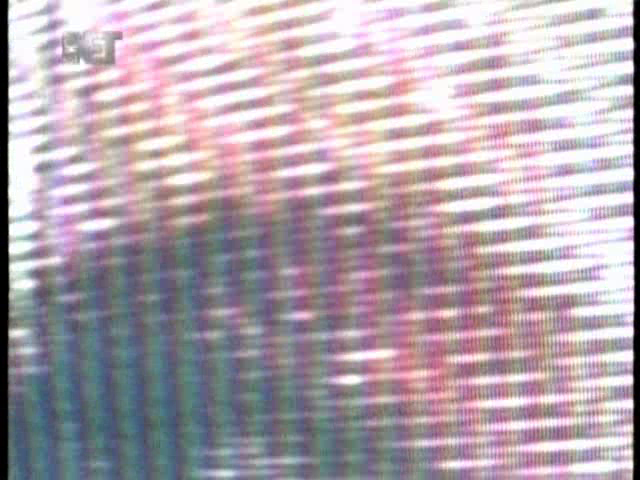
Haiku 2: Paper Dragon (Borjan Zafirovski, 2006, 4m) #CoMoNoMa
→ https://youtu.be/3nhF2iKJRgs?si=F1BWNCFkaOQssa81
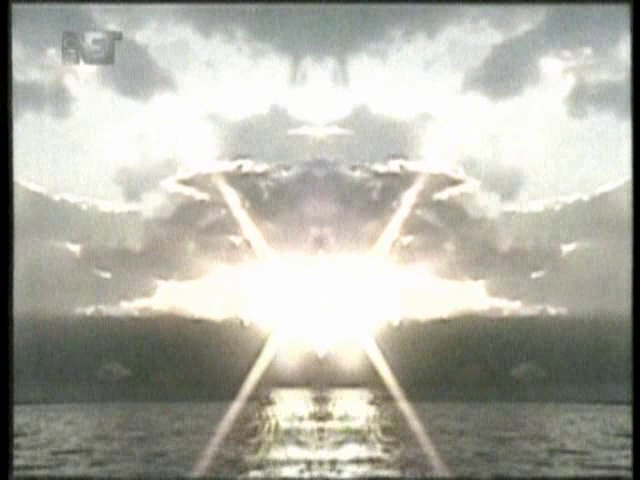

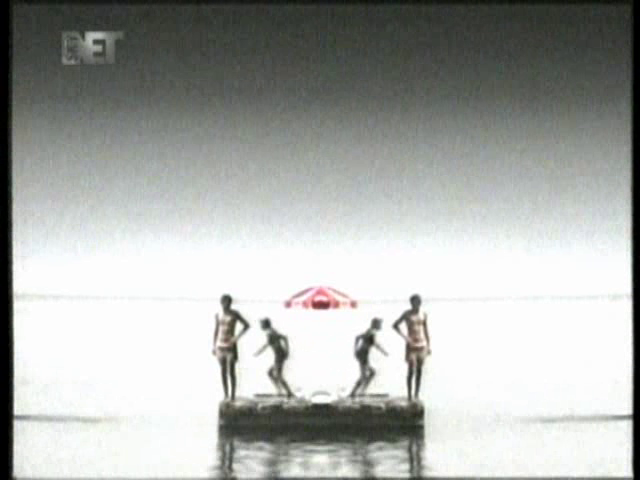
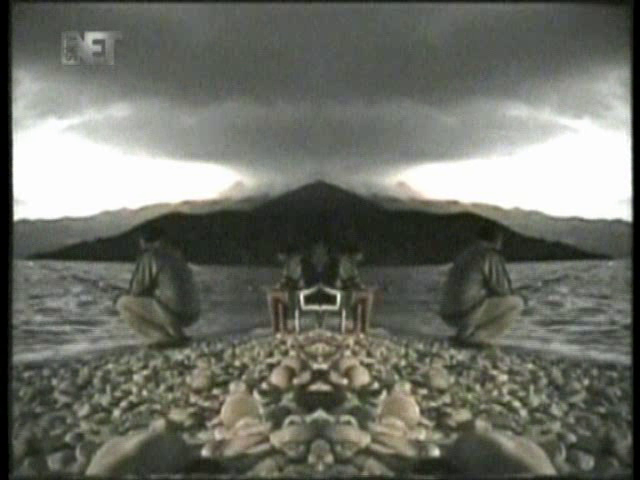
Haiku 3: Long Days (Borjan Zafirovski, 2006, 5m) #CoMoNoMa
→ https://youtu.be/XkmhGzH71JQ?si=KCN5EvmpJJpum8e0
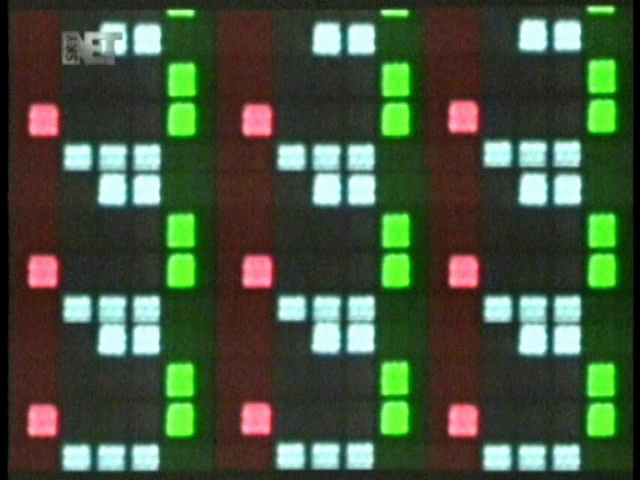
→ https://youtu.be/haVE9Or6pgY?si=EjXRCGws9BZZ0-TP

Haiku 2: Paper Dragon (Borjan Zafirovski, 2006, 4m) #CoMoNoMa
→ https://youtu.be/3nhF2iKJRgs?si=F1BWNCFkaOQssa81




Haiku 3: Long Days (Borjan Zafirovski, 2006, 5m) #CoMoNoMa
→ https://youtu.be/XkmhGzH71JQ?si=KCN5EvmpJJpum8e0

- Holdrüholoheuho
- Posts: 3200
- Joined: Sat Sep 05, 2020 12:30 am
- Location: Prague, Bohemia
-
Mario Gaborovic
- Posts: 252
- Joined: Fri Jan 04, 2019 8:54 am
This is how Macedonian Pat Benatar sounds. Unfortunately only a portion of the music video exists online, and not in good quality.

